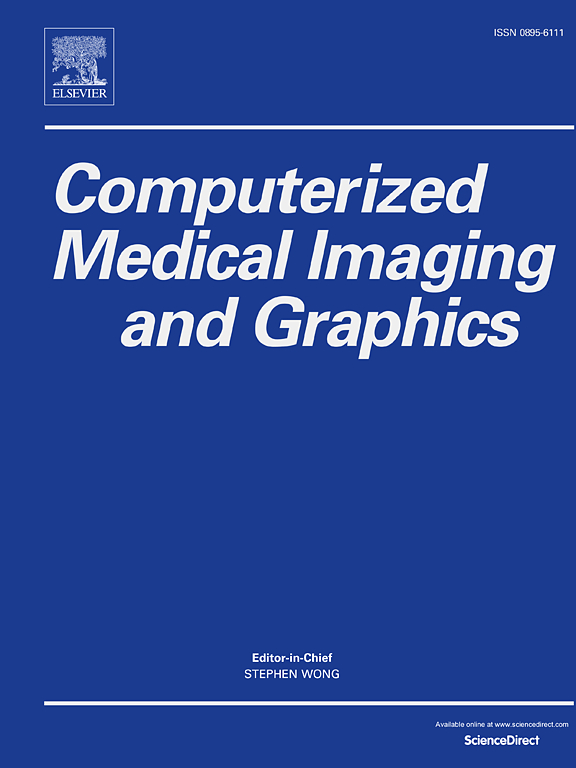Single color digital H&E staining with In-and-Out Net
IF 5.4
2区 医学
Q1 ENGINEERING, BIOMEDICAL
Computerized Medical Imaging and Graphics
Pub Date : 2024-11-20
DOI:10.1016/j.compmedimag.2024.102468
引用次数: 0
Abstract
Digital staining streamlines traditional staining procedures by digitally generating stained images from unstained or differently stained images. While conventional staining methods involve time-consuming chemical processes, digital staining offers an efficient and low-infrastructure alternative. Researchers can expedite tissue analysis without physical sectioning by leveraging microscopy-based techniques, such as confocal microscopy. However, interpreting grayscale or pseudo-color microscopic images remains challenging for pathologists and surgeons accustomed to traditional histologically stained images. To fill this gap, various studies explore digitally simulating staining to mimic targeted histological stains. This paper introduces a novel network, In-and-Out Net, designed explicitly for digital staining tasks. Based on Generative Adversarial Networks (GAN), our model efficiently transforms Reflectance Confocal Microscopy (RCM) images into Hematoxylin and Eosin (H&E) stained images. Using aluminum chloride preprocessing for skin tissue, we enhance nuclei contrast in RCM images. We trained the model with digital H&E labels featuring two fluorescence channels, eliminating the need for image registration and providing pixel-level ground truth. Our contributions include proposing an optimal training strategy, conducting a comparative analysis demonstrating state-of-the-art performance, validating the model through an ablation study, and collecting perfectly matched input and ground truth images without registration. In-and-Out Net showcases promising results, offering a valuable tool for digital staining tasks and advancing the field of histological image analysis.
单色数字 H&E 染色与进出网。
数字染色法通过从未染色或不同染色的图像中以数字方式生成染色图像,从而简化了传统染色程序。传统染色方法涉及耗时的化学过程,而数字染色提供了一种高效、低基础设施的替代方法。研究人员可以利用共聚焦显微镜等基于显微镜的技术,在不进行物理切片的情况下加快组织分析。然而,对于习惯于传统组织染色图像的病理学家和外科医生来说,解读灰度或伪彩色显微图像仍然是一项挑战。为了填补这一空白,各种研究都在探索以数字方式模拟染色,以模仿有针对性的组织学染色。本文介绍了一种专为数字染色任务设计的新型网络--In-and-Out Net。基于生成对抗网络(GAN),我们的模型能有效地将反射共聚焦显微镜(RCM)图像转换为苏木精和伊红(H&E)染色图像。通过对皮肤组织进行氯化铝预处理,我们增强了 RCM 图像中的细胞核对比度。我们使用具有两个荧光通道的数字 H&E 标签对模型进行了训练,从而消除了图像配准的需要,并提供了像素级的地面实况。我们的贡献包括提出了最佳训练策略,进行了比较分析,展示了最先进的性能,通过消融研究验证了模型,并收集了完全匹配的输入图像和无需配准的地面实况图像。In-and-Out Net展示了很有前景的结果,为数字染色任务提供了有价值的工具,推动了组织学图像分析领域的发展。
本文章由计算机程序翻译,如有差异,请以英文原文为准。
求助全文
约1分钟内获得全文
求助全文
来源期刊
CiteScore
10.70
自引率
3.50%
发文量
71
审稿时长
26 days
期刊介绍:
The purpose of the journal Computerized Medical Imaging and Graphics is to act as a source for the exchange of research results concerning algorithmic advances, development, and application of digital imaging in disease detection, diagnosis, intervention, prevention, precision medicine, and population health. Included in the journal will be articles on novel computerized imaging or visualization techniques, including artificial intelligence and machine learning, augmented reality for surgical planning and guidance, big biomedical data visualization, computer-aided diagnosis, computerized-robotic surgery, image-guided therapy, imaging scanning and reconstruction, mobile and tele-imaging, radiomics, and imaging integration and modeling with other information relevant to digital health. The types of biomedical imaging include: magnetic resonance, computed tomography, ultrasound, nuclear medicine, X-ray, microwave, optical and multi-photon microscopy, video and sensory imaging, and the convergence of biomedical images with other non-imaging datasets.

 求助内容:
求助内容: 应助结果提醒方式:
应助结果提醒方式:


